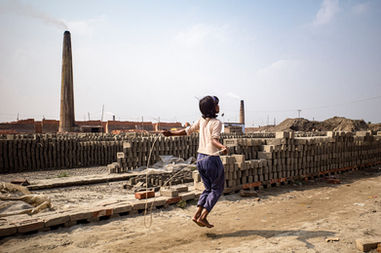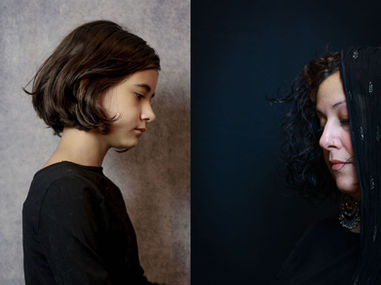
PICTORIAL STORY
July 10, 2020
RESILIENCE
Photography by Anwar Sadat
Story by Karin Svadlenak Gomez
Anwar Sadat is a Kenyan photographer whose vibrant scenes from his Kibera neighbourhood tell poignant stories — stories of community, of life's everyday joys and difficulties. Anwar (known by his artist name Sirdart) photographs both beautiful portraits of people in his community, and raw, in your face, street reportages. I interviewed him about life in Kibera. He wants us to see the oneness of people, their resilience, their hope for a better tomorrow, their willingness to take initiative, and their humble pride.
-min.jpg)
Kibera is famous for all the wrong reasons, when there are so many good reasons the world should know about it. Kenyan photographer Anwar Sadat calls it home. He regularly sets out to take photos that show life in the largest slum in the Kenyan capital, Nairobi, in all its facets. Anwar's photos go beyond the skin deep. Yes, they show a hard reality, but also the many residents who live life with a purpose, strive for improvement, and have a positive outlook. Growing up there, he neither liked nor understood it. “I couldn’t wait to move out,” he admits. “But as I grew older, I began to understand and see the reality of the people of Kibera and just how hard they work to achieve something better for themselves and their loved ones.” It is this reality that inspires his documentary photos.
Kibera, which in the Kinubi language means forest or jungle, started as a settlement in the forest outskirts of Nairobi, when the British colonial government allotted plots of land there to soldiers returning from service with the British Colonial regiment, the 'King's African Rifles' in 1904. Today it is the largest urban slum settlement in Africa, with population estimates varying wildly between approximately 170,000 to as many as a million people. Most of Kibera's residents live in extreme poverty. And although it is by no means the only slum in Nairobi, it is the most famous, probably for sheer size.
AN UPHILL STRUGGLE
Kibera's problems are many. The ground in much of Kibera is literally composed of refuse, and dwellings are often constructed atop this unstable ground. The environment is polluted from a lack of sanitation and waste management infrastructure, there is violence and crime, and residents often suffer from illnesses caused at least in part by poor nutrition and the inadequate hygiene facilities. Good work is hard to come by.
There have been and continue to be many upgrade projects by Non-government Organisations (NGOs) and the nearby United Nations Habitat programme. Moreover, there are also many locally grown initiatives to improve the lot of the community's poorest. It is an uphill struggle.
Sometimes, small accidents such as an overturned candle can lead to tragedy. In such cramped conditions, fires can spread quickly. Anwar witnessed such an event in 2019. Residents of a section of Kibera were left to count their losses as an early morning fire consumed all that they called their own.
“I have seen instances before where the community of Kibera has come together to support each other during a crisis, but none of them were like this,” he tells us. “Fire can be a good slave but a terrible master. As terrible as it can be, it can never beat the spirit of the people of Kibera.”
But amidst all that, life goes on. Anwar's photos show people living their busy lives, children going to school, a group of girls performing a dance.
Every day, men and women wake up early, mostly small business owners, go to Gikomba market (a larger flea market) to restock. Most of these individuals run their business from Toi market, another flea market located on the outskirts of Kibera. Although Kibera has a railway station, most people take buses and the small and not altogether safe matatus (minibus) to get from place to place.
HOPE
People in Kibera are keen on education. Most education centres in Kibera are informal or not regulated by the government, but there are also some government run schools.
At the Kibera School for Girls, which is run by a non-governmental organisation, they even hold mock United Nations leadership conferences, aimed at teaching girls about leadership and ways of finding solutions as leaders.
The PCEA Emmanuel Education Centre in Kibera makes do with the most basic of resources. All except the youngest students share a classroom, and the teachers have to teach different levels simultaneously. And yet, they hosted an international day of literacy event in 2019, when Anwar visited the school. The teacher, Benson Arita, was trying to multitask between being part of the event and making sure lessons run as usual in class. The school received an honorable mention for its dedication to teaching.
Basic necessities we take for granted are not necessarily available — things like sanitary towels for young women. A dance performance organised by a ballerina school in Kibera helped to raise awareness on children's talents and needs, while at the same time raising funds to purchase a three month supply of hygiene products for 1000 school girls. People find creative ways to deal with their needs.
Sports are also a very important aspect of life in Kibera. “Mostly it’s a good thing because it helps keep the youth busy away from crime and drugs,” says Anwar. There are many sports associations and organisations. Few players make it to play for national or even international teams, although it is every player's dream to play outside Kibera. But facilities are rather limited. The best equipped basketball court in Kibera belongs to a secondary school.
SELF-MADE
Many initiatives to improve the lives of Kibera residents are homegrown. For example in the face of the current added difficulty of the global Covid-19 pandemic, which is especially hard to contain when people are living in such close proximity, some residents are using their initiative to deal with the crisis.
Daniel Owino, a musician and music producer popularly known as Futwax by the locals, is using his talent, popularity and influence to sensitise his community. Kibera Town Centre is also stepping up the fight to raise awareness in the community on the necessity of protecting themselves and others against the spread of the virus.
One of the more creative ways to encourage new initiatives is the annual 'Miss' and 'Mister' contest. The show focuses on promoting talent and nurturing leadership skills. All the contestants are trained for a one month period in modelling skills and leadership. The actual contest involves a fashion show where the contestants model professional wear, casual wear, traditional wear and evening wear.
But the contest is much more than a fashion show. Contestants must come up with ideas that could help resolve some of the difficult challenges facing the people of Kibera. Judges — experts in different fields — select the winners based on how comprehensively they answer the questions and on their level of creativity. Mr. Kibera 2019/20, Dennis Andere, hopes to represent his people in the government in the next elections, to be held in the year 2022.
And in the words of Miss Kibera 2018/19, Wendy Ojalla "If only the world knew better, Kibera would not be defined by structures, but by the beautiful people who live there." Her idea was to find ways of giving Kibera's handicapped people a voice and have a chance to discuss access to equal opportunities. Given a chance, Kibera's handicapped could acquire the livelihood skills to allow them to live independently.

What Anwar wants us to take away from this story is that this is a vibrant strong community.
"I have experienced love, care, friendship, family, humility and respect in Kibera. I have learned to always work hard even with no hope, because hope is not always there. Kibera is not a desirable place to stay, it is most often forgotten and neglected by the government development projects. But having lived here long enough, I believe in the power of a sense of oneness and the people's will to create a better tomorrow for themselves regardless of all the difficulties and obstacles."
Where there is hope, there is initiative, and where there is initiative, there is a chance to overcome obstacles. This is what Anwar's documentary work shows very impressively.

The views, thoughts, and opinions expressed in the text belong solely to the author, and are not necessarily shared by The Pictorial List and the team.







































